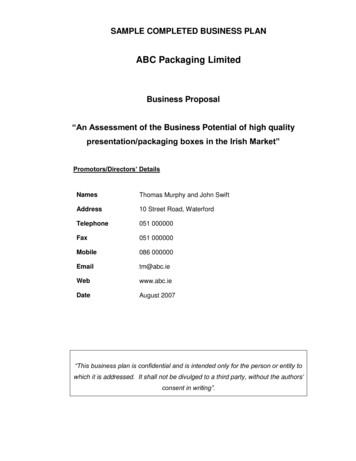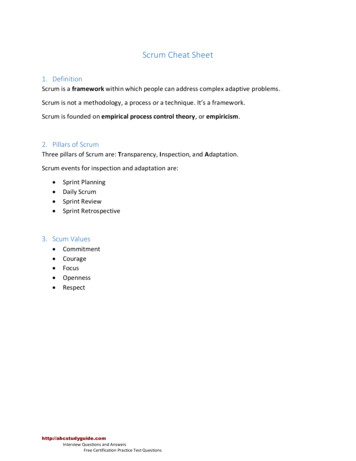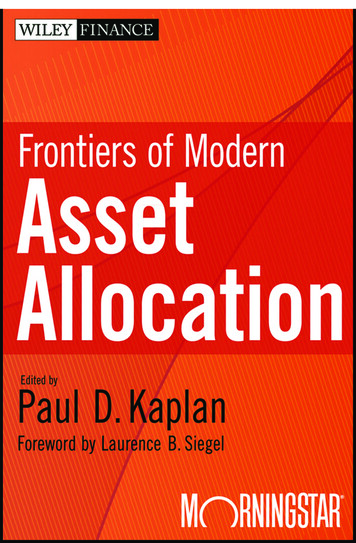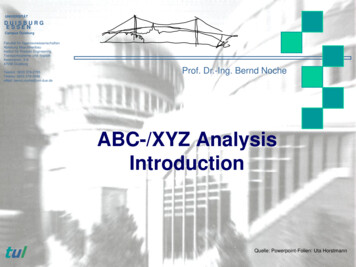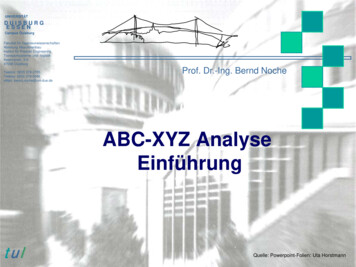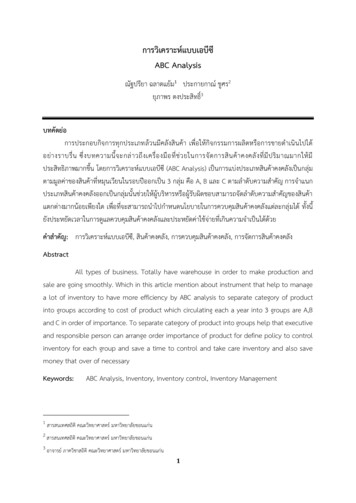
Transcription
The ABC Method: a riskmanagement approach to thepreservation of culturalheritage Government of Canada, Canadian Conservation Institute, 2016 ICCROM, 2016This publication has been designed in partnership with ICCROM(International Centre for the Study of the Preservation and Restoration ofCultural Property). No reproduction of this publication in any format ordistribution in print or online, in whole or in part, is authorized without priorwritten approval from the Canadian Conservation Institute. Requests can besubmitted by email to d by:Canadian Conservation Institute1030 Innes RoadOttawa, Ontario K1B 4S7CanadaÉgalement disponible en français.Stefan Michalski, CCIJosé Luiz Pedersoli Jr., ICCROMContact: stefan.michalski@canada.caISBN 978-0-660-04134-6Cat no. CH44-157/2016E-PDF
Table of ContentsOverviewIntroductionWelcome to heritage risk managementStructure of the manualWho can do this?Paper method or database?Origins of the ManualExamples of risk-based decision makingIntroductionDecisions about a single riskDecisions comparing two optionsDecisions comparing several risksDecisions comparing risks in an asset of buildings plus collectionsDecisions based on a comprehensive risk assessmentIntegrated risk managementMethods of risk-based decision makingDefining and measuring riskMapping risksThe risk management cycleAnalysis of a single riskAssessing risks of the same kindComparative risk assessmentComprehensive risk assessmentComprehensive risk managementIntegrated risk managementBackground ideas of risk-based decision makingRethinking disaster risk management and emergency preparednessIntegrating collections with sites and buildingsUncertainty and anxietyThe goal of heritage risk managementTime horizon and the social discount rateThe equivalence of fractional loss with the chance of total lossSummary list of tasksStep 1: Establish the ContextTasks for the establish the context stepTask 1: Consult with decision makers. Define the scope, goals and criteriaTask 2: Collect and understand the relevant informationTask 3: Build the value pieExplanations for the establish the context stepTask scope and time horizonMandate, policies, and procedures of the organizationLegal contextFinancial contextGovernance contextStakeholdersThe value pie: IntroductionThe value pie: Setting up the tableThe value pie: Using value categoriesThe value pie: When items aren’t so easily defined3
The value pie: Using values directly as intangible itemsThe value pie: Multiple contributing values to each itemItems with multiple values: A worked exampleThe value pie: Capturing ensemble valueThe value pie: Applying it to only some parts of the heritage assetThe value pie affects risk assessmentStep 2: Identify RisksTasks for the identify risks stepTask 1: Assemble the appropriate tools and strategiesTask 2: Survey the heritage asset and make a photographic recordTask 3: Identify specific risks, name them, and write their summary sentencesExplanations for the identify stepIdentify specific risksWrite the risk summary sentencesSusceptible and exposed affectedChecklistsFrameworks and their purposeThe 10 “Agents” of deteriorationThe causal chain from hazard to adverse effect, via the 10 agentsThe three “Types” of risk occurrence“Rare” as a rigorously defined termThe five “Stages” of controlThe six “Layers” around the heritage assetThe three sources of knowledgeComprehensive risk identification: The Ten Agents and Three Types of Occurrence TableComprehensive risk identification: Use efficient paths for surveysRare events and regional dataCollecting local knowledgeIdentifying risks by causes other than the 10 agentsStep 3: Analyze RisksTasks for the analyze stepTask 1: Quantify each specific riskTask 2: Split or combine specific risks, as neededTask 3: Review and refine the analysesExplanations for the analyze stepThe three ABC components for quantification of riskThe ABC scalesA scale: Frequency or rateB scale: Loss of value to each affected itemC scale: Items affectedDo you want paper or electronic?The risk scenarioAnalyzing A for rare eventsAnalyzing A for common eventsAnalyzing A for cumulative processesAnalyzing A using a time horizonAnalyzing which items to include: Check the value pie for guidanceAnalyzing B when loss is totalWhen loss is partial: Analysis of the deteriorationWhen loss is partial: From deterioration to loss of valueWhen loss is partial: Using fractionsWhen loss is partial: Using diagramsWhen loss is partial: Using wordsWhen loss is partial: Using equivalence to total loss4
When loss is partial: Equivalence chainsWhen loss is partial: Value judgements may not be necessaryAnalyzing C if all items have equal valueAnalyzing C when items vary in valueAnalyzing a risk by using the probable institutional responseReview for coherence in the analysis of the three componentsFinding knowledgeKnowledge phases during risk analysisAggregating and disaggregating specific risksFacts plus theories: The general method for analyzing scenariosTheory: Exposure to eventsTheory: Exposure to cumulative processesAnalyzing risks by control levelsCan we predict the future?Making deductions from the evidence of past adverse effectsSeparating the technical issues from the subjective issues during the analyze stepThe arithmetic behind the ABC scoresStep 4: Evaluate RisksTasks for the evaluate risks stepTask 1: Compare risks to each other, to criteria, to expectationsTask 2. Evaluate the sensitivity of prioritization to changes in the value pieTask 3: Evaluate uncertainty, constraints, opportunitiesExplanations for the evaluate risks stepAn example of a magnitude graphMagnitude of risk scale with implicationsThe Magnitude of Risk vs. Uncertainty TableDiscussing the influence of the value pie on prioritizationWorking backwards from MR to value pieStep 5: Treat RisksTasks for the treat risks stepTask 1: Identify risk treatment optionsTask 2: Quantify risk reduction optionsTask 3: Evaluate risk reduction optionsTask 4: Plan and implement selected optionsExplanations of the treat risk stepDeveloping options: Types of risk treatmentDeveloping options: Creation processesDeveloping options: The Layers and Stages MatrixComplex optionsCost-effectiveness calculation, simpleCost-effectiveness calculation, preciseThe Option Summary TableThe risk treatment planConclusionMonitor and review long-termMonitor and review risksMonitor and review information sourcesMonitor and review the value pieWas the goal achieved?The ultimate review questionThe best available answer will remain uncertainBad news, good newsReferencesGlossary5
The main lesson from these experiences has been that scientificexpertise, rational decision making, and public values can be reconciled ifthere is a serious attempt to integrate them. The transformation of the riskarena into a cooperative risk discourse seems to be an essential andultimately inevitable step to improve risk policies and risk management.—O. Renn, “The Challenge of Integrating Deliberation and Expertise,” inRisk Analysis and SocietyNo one is distressed by failing to see very subtle points that requirespecialized knowledge. We are distressed, however, if we overlook theobvious.—D. Dörner, The Logic of Failure: Recognizing and Avoiding Error inComplex Situations6
Overview7
IntroductionWelcome to heritage risk managementWhy use it?If you have ever wondered what to do when facing a pressing and difficult preservationdecision, then this method can help.If you have ever wondered how to balance preservation with sustainability, shrinkingresources, user demands, and public accountability, then this method can help. Finally,if you have ever wondered how to present all this succinctly to decision makers, withtransparent priorities, then this method can help.The goal of heritage risk managementIn simple language, our goal is the best preservation of the value of the heritage assetwith the available resources.In more technical terms, our goal is to assess the risks and deterioration processesaffecting our heritage asset, and then to act to reduce them as effectively as possible,given the available resources.What is risk-based decision making?Risk-based decision making is the application of risk assessments to a decision. Thedistinction with risk management is only a matter of degree. Many useful preservationdecisions can be made using very focused assessments of one or two risks. If, on theother hand, one wants to “manage” risks of a heritage asset, one needs assessments ofmost, if not all, of the risks.8
Structure of the manualOverview sectionThe Overview section summarizes the who, what, why, and how of the method. Severalexamples of its use are provided. It opens the door to thinking about not onlycomprehensive risk management, but also smaller decisions within heritagepreservation, i.e. risk-based decision making.The five stepsThe core of the manual is built around the five steps of a management cycle. These are:1.2.3.4.5.Establish the contextIdentify risksAnalyze risksEvaluate risksTreat risksWithin each of the steps, the manual provides a subsection on tasks and a subsectionof explanations.TasksFor each of the five steps, three or more tasks have been outlined. The sections oneach step begin with these tasks. Each task is explained by one page of detailedactivities.Who can do this?Anyone responsible for heritage preservationThis manual outlines the ideas behind risk management of heritage assets, such ascollections, buildings, and sites, and provides a step-by-step procedure for doing it.Once you begin to view preservation decisions from this perspective, you will be “doing”heritage risk management.A participatory processRisk management involves many players inside and outside the organization. Thismanual can be used to inform all participants.Just want the big picture?For those just curious about the method, or who have been asked to participate in theprocess, please read the Overview section.9
First-time user?This manual was developed as a resource for a course in the method. The best way touse it is in the context of mentoring or training.If you are trying to apply the full method for the first time, without the benefit of ateacher, we suggest that you begin by reading the entire manual. Then locate one of themany individuals around the world who have taken the ICCROM course called“Reducing Risks to Collections” (see the ICCROM website for lists of participants) andwho are passionate about sharing and building the method. Canadians can contact CCIfor assistance; others, please contact the organization ICCROM.Paper method or database?PaperThis method can be applied using only paper forms. Some calculations and graphingwill be necessary. This can be managed with a calculator or by using spreadsheetsoftware such as Microsoft Excel or OpenOffice.DatabaseThe most convenient tool is the CCI Risk Management Database, developedspecifically for the method. It automates all the calculations necessary forcomprehensive assessments and the evaluation of risk reduction options. It generatesreports based on your data and text entries. For information on the database, contactCCI.10
Origins of the ManualPartner InstitutionsFrom 2006 until 2012, ICCROM, the Canadian Conservation Institute (CCI), and theNetherlands Cultural Heritage Agency (RCE; formerly the Institute for Cultural Heritage,ICN) established a collaboration framework “to create an international shift in attitudefrom traditional preventive conservation practice to risk management within the heritageprofession.” Among the activities of this collaboration were research, training anddissemination, and the production of resource materials, which CCI was to lead.Manual backgroundThis manual was conceived in the framework of that collaboration. Since then, the texthas been substantially revised based on the experience of CCI in applying the ABCmethod to Canadian institutions and that of ICCROM in projects carried out in LatinAmerica, Asia, and Europe.AcknowledgementsThe training initiatives were coordinated by ICCROM in the framework of thepartnership. Content was developed and delivered by staff of ICCROM (CatherineAntomarchi, José Luiz Pedersoli, and Isabelle Verger); staff of CCI (Stefan Michalski,Irene Karsten, Julie Stevenson, Jean Tétreault, Tom Strang, Paul Marcon); staff of ICN(Agnes Brokerhof, Bart Ankersmit, Frank Ligterink). Early development of these coursesbenefited from the ideas and experience of Robert Waller while he was head of theconservation section at the Canadian Museum of Nature. Other contributors included:Veerle Meul, while with Monumentenwacht Vlaanderen, Belgium; and Jonathan AshleySmith, United Kingdom. A special thanks to Vesna Zivkovic, head of the preventiveconservation section at the Central Institute of Conservation of Serbia, who developedthe course glossary, many course resources, and tools.A final thanks to Catherine Antomarchi for her careful review and many improvementsof both the English and French versions.AuthorsThe lead author of this manual was Stefan Michalski at CCI(stefan.michalski@canada.ca). Co-author was José Luiz Pedersoli Jr. for ICCROM.11
Examples of risk-based decision makingIntroductionThese examples illustrate the variable scope of risk-based decision making, from smallto large. Some come from the participants’ case work during the ICCROM-CCI-ICNcourses “Reducing Risks to Collections.” The rest were created by considering howcommon preservation decisions can be considered from a risk-based approach. It is ourhope that these examples inspire users to consider many preservation decisions fromthe risk perspective, not necessarily with the full methodology of the manual, but at leastwith the fundamental ideas.Decisions about a single riskDocuments in “bad” boxesThe staff of an archive in a small museum know that standard “best practice advice”states that they must repl
Analysis of a single risk Assessing risks of the same kind Comparative risk assessment Comprehensive risk assessment Comprehensive risk management Integrated risk management Background ideas of risk-based decision making Rethinking disaster risk management and emergency preparedness Integrating collections with sites and buildings Uncertainty and anxiety The goal of




